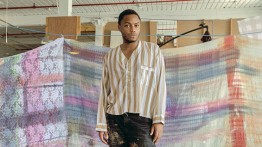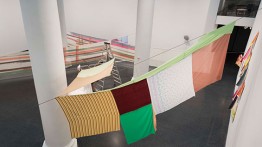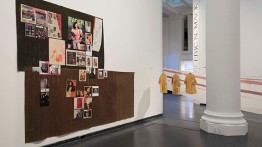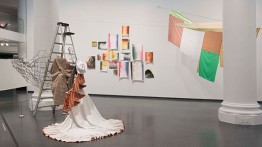Eric N. Mack A’10 at the Brooklyn Museum
POSTED ON: April 23, 2019
Artist Eric N. Mack A’10 has taken over the Brooklyn Museum’s Great Hall with his first New York City solo museum exhibition, Lemme walk across the room. The site-responsive installation features Mack’s collage and textile-based works, incorporating nontraditional materials that reflect the artist’s interest in collapsing boundaries between forms and exploring the relationships between art and everyday life.
As visitors enter the gallery from the museum lobby, they encounter dyed, stained, and hand-painted “fabric collages” dividing the space. Citing influences such as artist Sam Gilliam and the history of the Readymade, the Cooper alumnus describes his practice as challenging the tradition of painting on stretched canvas by instead draping fabric across wires. Visitors are encouraged to move around and actively engage with the architecture of the gallery and its large classical columns. Mack’s questioning of artistic, spatial, and cultural boundaries also takes the form of repurposing clippings from popular magazines, fashion photography, and hip-hop imagery, mounted as collages and on pegboard displays.
“Eric’s show is a tour de force that represents all that is unique about Cooper,” says Adriana Farmiga, Associate Dean and adjunct instructor at the School of Art. “It’s any one/all of: site specific installation, performance, sculpture, drawing, design, color, and painting. We’re so proud of him.”
Mack, who lives in New York City, also earned his MFA from Yale after graduating from Cooper. In 2014–2015, he was an artist-in-residence at the Studio Museum in Harlem. Following the success of his shows at Simon Lee Gallery in 2018 and the Albright-Knox Art Gallery in 2017, he was invited by the Brooklyn Museum to show his work in a solo exhibition. Lemme walk across the room, which includes both new and existing pieces, showcases Mack's continuing fascination with creative practice as a living, responsive, and multi-sensorial experience.
The solo show coincides with Mack's inclusion in the current Whitney Biennial, Proposition: for wet Gee’s Bend Quilts to replace the American flag—Permanently. (2019). "Eric N. Mack has never looked better," writes Andrew Russeth, an art critic and executive editor of ARTnews, describing the piece as "an exuberant and carefully balanced mélange of disparate fabrics that are stitched together and hung from wires, nodding gallantly to Joe Overstreet, Gee’s Bend quilters, and Eva Hesse." The reference is notable since Hesse is a 1957 School of Art graduate.
Lemme walk across the room will be on view at the Brooklyn Museum through August 4th. The Whitney Biennial closes September 22.









